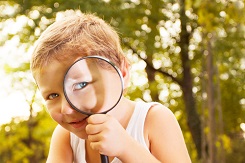10 Science Projects to Boost Investigative Skills in School-Aged Children
June 20, 2013 | in Nannies
By Erin McNeill
 Science sparks curiosity in even the youngest children, but as your children get older, they are ready for more complex experiments and concepts. Encourage them to explore the things that they love, but also set them up to explore things that are unknown to them. By creating a safe environment in which they can explore, you are setting them up to ask questions and investigate even further! Here are a few projects to get your young scientist involved.
Science sparks curiosity in even the youngest children, but as your children get older, they are ready for more complex experiments and concepts. Encourage them to explore the things that they love, but also set them up to explore things that are unknown to them. By creating a safe environment in which they can explore, you are setting them up to ask questions and investigate even further! Here are a few projects to get your young scientist involved.
- Magic ink – Using lemon juice, write a message on a piece of paper and let it dry. To reveal the message, hold the paper over a light bulb and watch as the message magically appears again! The heat from the bulb will react with the lemon juice and turn it brown, making it visible on the paper!
- Hover craft – You can make your own hover craft with an old CD, a bottle top (sports type) and a balloon. Use hot glue to attach the bottle top over the hole of the CD, making sure to leave the CD hole open. Once the glue has set, blow up the balloon and place over the bottle cap. When ready, release the balloon and watch the CD hover above the surface. Ask your child how they think it works, then research hover crafts together.
- Blobs in a bottle – Use a one liter bottle and add ¾ cup of water to it. Fill it the rest of the way with vegetable oil. When you add a few drops of food coloring, it will sink to the bottom and mix with the water. The last step is to add fizzing tablets, such as Alka-Seltzer, ½ a tablet at a time. Shake the bottle and watch the blobs float up and down in the bottle. Once the action stops, simply add another ½ of a tablet to see it all happen again.
- Balloon rockets – Place half of a straw on a long piece of string and attach the string on both ends so that it hangs straight across the room. Blow up a balloon and attach it to the straw with a piece of tape. Release the end of the balloon and watch your balloon rocket itself across the room.
- Rubber chicken – Place a chicken bone in vinegar for three days. Remove it from the vinegar and compare it to a chicken bone that hasn’t been submersed in vinegar. What is different between the bones? What happened to the one in vinegar?
- Oobleck – Oobleck is an interesting homemade substance that is fun to make! You need 4 tablespoons of corn starch, 1 tablespoon of warm water and a few drops of food coloring. Mix them together and watch the substances transform. What happened when you mixed the ingredients together? Can you separate them again?
- Floating ball – Use a straw to blow air up into the sky. While doing this, place a ping pong ball above the air stream and try to keep it there while blowing through the straw. Why does this work?
- Color flowers – You can make your own flowers with color! Fill a glass with water and add 10 drops of food coloring, then place carnations with stems in the colored water. Watch what happens to them as they begin to suck up the water from the glass.
- Gumdrop architecture – Use toothpicks and gumdrops to create bridges, skyscrapers and other buildings. Who can build the longest bridge? Who can build the tallest building? You can also use clay or marshmallows in place of the gumdrops. Compare using different mediums to stick the toothpicks together.
- Fossils – Gather some shells, rocks, feathers and whatever else you can find in nature. Form a boat out of a small piece of foil. Mix some Plaster of Paris together and fill the foil bowl. Lightly press your object into the plaster and remove it before it is all the way dry (Plaster of Paris dries fairly quickly, so work fast!). Create a museum of all of your artifacts!
Remember to be patient as your child makes a mess and asks a ton of questions throughout the science process; that’s what science is! Once your child finds out one piece of information, it will likely lead to wanting to know more about the world around her. Encourage her to ask questions, formulate theories and explore!
← 10 Ideas for Summer Fun in Your Own Backyard | How to Create a Neighborhood Camp for Kids →Comments are closed.
Search for nanny jobs
in your zipcode:






